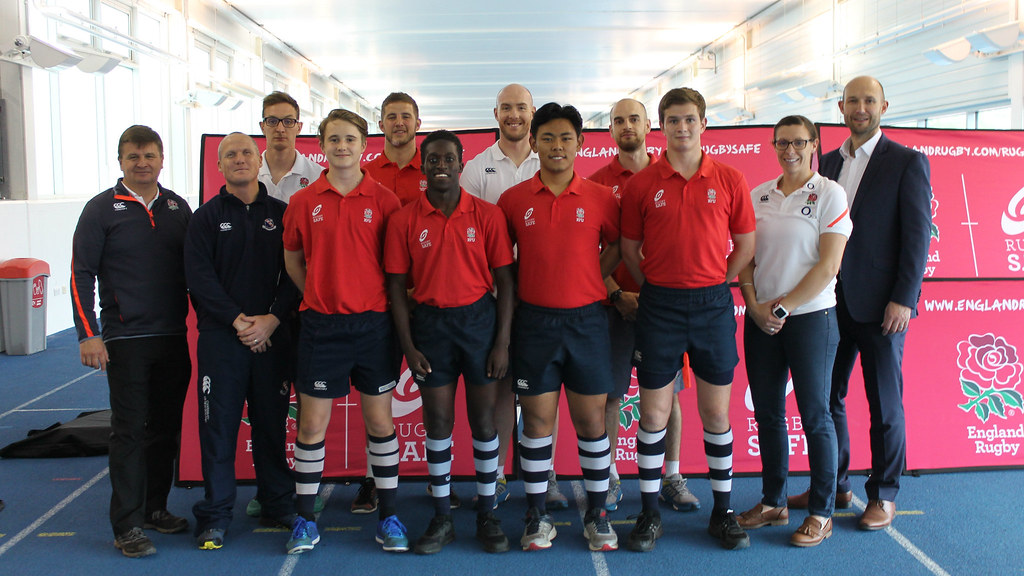Published in the British Journal of Sports Medicine, the findings of the School Injury Prevention Study – which was led by the University's Department for Health and the Rugby Football Union (RFU) from 2013-16 – show the dramatic effect of a newly-devised exercise programme in reducing overall injuries for youth rugby.
The recommendations will now be rolled out nationwide by the RFU in preparation for next season.
Dramatic reduction in injuries
For the study, which involved 40 schools and nearly 2,500 players aged 14 – 18, the researchers found that overall injuries fell by 72% when players completed the new exercises at least three times a week. Concussion injuries were reduced by 59%.
The new training and pre-match exercise programme was developed by the research team as part of the study. It focuses on balance, strength and agility in order to better prepare players for the physical challenges they face in matches and to mitigate potential injury risks. Split into four stages it takes roughly 20 minutes to complete.
Reducing injuries in youth rugby from University of Bath on Vimeo.
This is made up of: a running warm-up with change of direction activities (2 minutes); lower-limb balance training (4 minutes); targeted resistance exercises (8 minutes); plus jumping, side-stepping and landing exercises (6 minutes).
Season-long intervention
The programme is a season-long intervention aimed at under 15s to under 18s. Every 4 weeks within the season the specific exercises change to reflect the progress the players have made.
Professor Keith Stokes, who led the study from the University, explained: “Over recent years, injury risk in youth rugby has received much attention highlighting the importance of establishing new, evidence-based injury reduction strategies.
“Our results are exciting because they show that carrying out a simple set of exercises on a regular basis can substantially reduce injuries in youth rugby. We believe these findings will have a significant impact in helping to improve player welfare, making the game safer for young players to enjoy.”
The RFU, who commissioned the study, will roll out these findings across the community game and are developing training resources for clubs, schools and coaches.
Dr Mike England, RFU Community Rugby Medical Director, added: “We invested in this ground-breaking study as part of our commitment to player welfare. It is a key step in our systematic approach to injury prevention.
“The results are impressive and we hope that a related study showing similar effects in the adult community game will be published soon.
“The RFU plans to roll out this approach across the community game in England and we will be training our local delivery workforce to help clubs, schools, colleges and universities adopt this type of training and realise the potential benefits for players.”
World Rugby Chief Medical Officer, Dr Martin Raftery said: “World Rugby applauds the RFU and the University of Bath on another important and high-quality piece of research that further demonstrates rugby’s commitment to an evidence-driven player welfare approach. We will discuss with both parties how this body of work can be applied to benefit the global game.”
For the past 10 years the Rugby Science team within the Department for Health at the University have been working closely with the RFU and the RFU Injured Players Foundation to understand more about injury risks in rugby and ways to reduce them.
This important collaboration has also included the research carried out with World Rugby, the RFU and the RFU Injured Players Foundation to reduce the forces in the scrum. This resulted in the change in scrum engagement technique to ‘crouch, bind, set’ which was introduced globally in 2013 through the World Rugby Law change.
Access the study
To access the latest study, ‘Reducing musculoskeletal injury and concussion risk in schoolboy rugby players with pre-activity movement control exercise programme: a cluster randomised controlled trial’, published in the British Journal of Sport Medicine (DOI 10.1136/bjsports-2016-097434) see http://opus.bath.ac.uk/55275/.
If you found this interesting, you might also enjoy reading:

